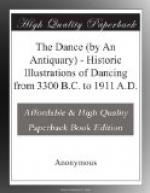“In later times, it appears more transparent and folded in narrow pleats.[Footnote: There is a picture of an Egyptian gauffering machine in Wilkinson, vol. i., p. 185.] Some danced in pairs, holding each other’s hand; others went through a succession of steps alone, both men and women; sometimes a man performed a solo to the sound of music or the clapping of hands.
“A favourite figure dance was universally adopted throughout the country, in which two partners, who were usually men, advanced toward each other, or stood face to face upon one leg, and having performed a series of movements, retired again in opposite directions, continuing to hold by one hand and concluding by turning each other round (see fig. 3). That the attitude was very common is proved by its having been adopted by the hieroglyphic (fig. 4) as the mode of describing ‘dance.’”
[Illustration: Fig. 3.—The hieroglyphics describe the dance.]
[Illustration: Fig. 4.—Egyptian hieroglyphic for “dance.”]
Many of the positions of the dance illustrated in Gardner Wilkinson are used at the present day.
The ASSYRIANS probably danced as much as the other nations, but amongst the many monuments that have been discovered there is little dancing shown, and they were evidently more proud of their campaigns and their hunting than of their dancing. A stern and strong people, although they undoubtedly had this amusement, we know little about it. Of the Phoenicians, their neighbours, we have some illustrations of their dance, which was apparently of a serious nature, judging by the examples which we possess, such as that (fig. 5) from Cyprus representing three figures in hooded cowls dancing around a piper. It is a dance around a centre, as is also (fig. 6) that from Idalium in Cyprus. The latter is engraved around a bronze bowl and is evidently a planet and sun dance before a goddess, in a temple; the sun being the central object around which they dance, accompanied by the double pipes, the harp, and tabour. The Egyptian origin of the devotion is apparent in the details, especially in the lotus-smelling goddess (marked A on fig. 6) who holds the flower in the manner shown in an Egyptian painting in the British Museum (fig. 7).
[Illustration: Fig. 5.—Cyprian limestone group of Phoenician dancers, about 6-1/2 in. high. There is a somewhat similar group, also from Cyprus, in the British Museum. The dress, a hooded cowl, appears to be of great antiquity.]
From the Phoenicians we have illustrated examples, but no record, whereas from their neighbours the Hebrews we have ample records in the Scriptures, but no illustrations. It is, however, most probable that the dance with them had the traditional character of the nations around them or who had held them captive, and the Philistine dance (fig. 6) may have been of the same kind as that around the golden calf (Apis) of the desert (Exodus xxxii. v. 19).




